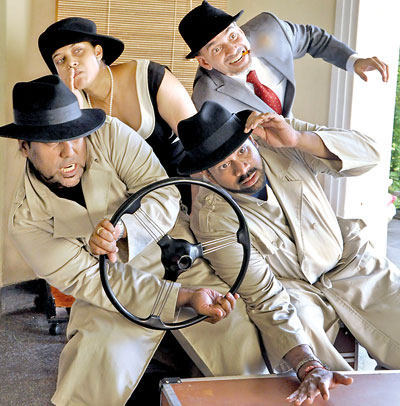A ‘kottu roti dish of Hitchcock vignettes’ served with aplomb!
Review of The 39 Steps, that ends today at the Lionel Wendt Theatre
When Hitchcock turned John Buchan’s swashbuckling 1915 story of a fiendish gang of spies defeated by an imperturbable English gentleman-hero in a wild chase all over Scotland, he beefed up the action, cranked up the love interest and turned it from a ripping fireside yarn into an adventure thriller.

Taken for a ride: The four actors at rehearsals. Pic by Indika Handuwala
The 2005 staged spoof of the classic Hitchcock film, that has four actors feverishly playing the main parts plus all the weird and wonderful characters hero Richard Hannay meets on his chase across the highlands and lowlands of Scotland and back into England, is inspired nuttiness, and the Performing Arts Company’s production currently running at the Lionel Wendt Theatre, delivered in spades.
It is both a play with a story and a play outside the play, in which the audience watches four actors gamely and frantically determined to replicate Hitchcock’s entire screen epic, including a torrential river crossing, a jolting car ride, a nine-person Scottish marching band, a train, the famous Forth Bridge and heaven knows what else on the bare boards of a stage, with dozens of bit parts flung into the mix – sometimes with an actor playing two parts at the one time – and barely a heartbeat lost between 38 scene changes and a total of 49 roles.
Far from surrendering to the fact that the stage has no hope of competing with film in sweeping, fast-changing action, the production pretends that it can, in fact, do it all, and the audience’s sympathies are enlisted in the enterprise. The result emphasises the wonderful advantage stage and books have over film: the firing of imagination to make a magic carpet ride through a story.
British playwright Patrick Barlow of the Wessex-like Brent Theatre Company turned the film narrative of The 39 Steps into a kottu roti dish of vignettes from the film. The Hannay narrative is used only to serve up the whacky episodes. The bit-part players become the stars.
The play has been performed in several countries, won the Olivier Award for best comedy, and became one of the longest-running productions on Broadway in recent years.
Actors Sean Amarasekera and Arjuna Wignaraja rose to the challenge magnificently and delivered a rumbustious series of comedy acts. Ashini Fernando, who had three assorted parts to play – a mysterious spy who dies in Hannay’s flat, the love interest he meets on his journey, and a Scottish crofter’s shy wife – dashingly played each distinctive role. Mohamed Adamally (Hannay), in a “faint but pursuing” manner courageously delivered on his role that used to once be heroic but which somehow became relegated to a sort of butler’s part.
The comedy throughout was intense and clever, and while the bit part stars galloped away with the show in general, Adamally made the fullest use of two episodes. His excruciated delight when, while being handcuffed to him, Fernando (in the role of the glam blonde love interest) carefully rolls down her wet stockings, Hannay’s nerveless hands travelling lingeringly and yet passively up and down her legs, was a joy to watch, as was his part – and Amarasekera’s – in a political meeting.
A couple of slight quibbles: Barlow said in an interview that “there is a rather beautiful love story in there”, and that he had to keep true to the thriller and the romance. For me, the love story got chopped up in the vaudeville kottu – whether this mattered or not is another question.
Also, I am not sure that the English penchant for making fun out of broad Scottish accents translates to a 2013 Sri Lankan audience, highly amusing though it was and though Amarasekera’s and Wignaraja’s mastery of the accents was comparable to the best of the BBC.
The production, directed strongly by Nafeesa K. Amiruddeen, is technically very good, with everything happening flawlessly at blinding speed. This would have taken hours and hours of disciplined rehearsal by actors and stage-hands, who deservedly got a curtain-call at the end.
A group of theatre-goers sitting behind me agreed that the plot sucked but that the play was very funny, and that rather sums it up. Who said, “The play’s the thing …”?
Follow @timesonlinelk
comments powered by Disqus


